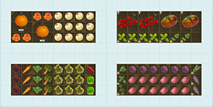How to grow Cucumber?
- Latin Family: Cucurbitaceae
- Latin Genus: Cucumis
- Ease of Growing: Easy
- Growing Type: Annual
Cucumbers take up quite a bit of space, but they are tasty, productive and have an extended harvest season.
Videos
Cucumber History
This tropical species is thought to have come from India or thereabouts as it has long been cultivated there. It reached Europe quite early and was widely grown by the time of the Romans.
Soil Preference
- PH (min/max): 6.0 - 7.0
- PH Ideal (min/max): 6.4 - 6.6
Cucumbers grow rapidly once established and to sustain their high level of growth they need a rich soil. It should be loose, moisture-retentive and well-drained, with lots of organic matter. Raised beds are good for Cucumbers, because they help the soil warm up quickly and provide good drainage.
How to care for Cucumber?
If you give them everything they need, growing Cucumbers is fairly straightforward.
Water
Cucumbers are mainly composed of water and need a constant and abundant supply of it for best growth.
The best way to water Cucumbers is with a drip system or soaker hose, as this keeps the leaves dry and so reduces the chance of disease problems. If you must get the leaves wet, water in the morning, or early evening, so they have a chance to dry out quickly. You don't want the leaves to stay wet all night.
Be careful not to overwater germinating seeds or they may rot. It's best to soak the ground or the potting soil heavily when first planting, then avoid watering again if possible until seedlings emerge. Cucumber seeds emerge in 5+ days; very lightly water ground or potting soil around day 3 or 4 to keep soil from crusting so that seeds can emerge more easily.
Fertilizer
Cucumber grows fast and produces a lot of foliage, so its no surprise that it is a fairly hungry plant and likes fertile soil.
Seeds
Seed Viability: 2-5 years
Germination Percentage: 80.0
Cucumbers are cross-pollinated by bees, and so must either be isolated by at least 1000 yards or hand pollinated. Hand pollination is fairly straightforward because the flowers are so large. It is done in the same way as for Squash flowers. Make sure you select the best and most typical plants for producing seed.
If you are saving seed, the fruit must be allowed to mature properly. It will turn yellow and start to wither when fully ripe. Separate the seeds from the pulp and ferment them for a couple of days in water. Finally, separate the cleaned seeds from the fermented mush and dry them thoroughly. Ideally they should have a moisture content of around 6% for storage. Be aware that a number of diseases can be seed borne.
Light
Sun: min. 6 hours daily
Needs full sun.
Conditions:Warm, Hot
Season:Short Season, Long Season
Storage
Cucumbers can be pickled and stored in jars in the pantry.
Storage Req: Canning
Storage Temp: 50-70°F
Storage Length: 1-360 days
Cucumbers should be stored in a cool place (40 to 50˚ F), but not as cold as a refrigerator. They don’t keep for much more than a week, which is probably why pickling became popular.
Storage Req: Cool
Storage Temp: 40-50°F
Storage Length: 1-7 days
Problems
Don’t start plants too early
Don’t start the plants too early, as you can’t put them out until the soil is warm (60˚ F minimum). If they sit inside too long, they will get root bound. Plants set out at the right time will quickly outgrow those planted too early.
Disease
Powdery mildew occurs during hot, dry spells, whereas downy mildew occurs during wet, cool spells near the end of the growing season. Mosaic virus causes a yellow and green mottling of the leaves and reduces plant vigor. Anthracnose, a fungus disease, is most common during mid- and late- season and during dry weather. Dark brown spots on the leaves and round sunken spots on the fruit are evidence of Anthracnose. Another fungus, angular leaf spot, is common during cool, wet weather. Symptoms of angular leaf spot include interveinal browning and small circular spots on the fruit. Bacterial wilt causes sudden dramatic wilting and death of the vines. Use resistant or tolerant varieties, practice good sanitation and crop rotation, and pay attention to proper growth requirements.
Cucumber Types
- Slicing
- Specialty
- Pickling
These cucumbers produce large fruits which are traditionally cut into slices for use in salads and as a garnish. They are a fast growing crop under good growing conditions.
These cucumbers produce large fruits which are traditionally cut into slices for use in salads and as a garnish. They are a fast growing crop under good growing conditions.
These cucumbers produce large, uniformly sized fruits which are traditionally preserved by pickling them. They tend to be shorter and thicker than slicing cucumbers, with a bumpy exterior and white spines. They are a fast growing crop under good growing conditions.
Pests
- Aphids
- Deer
- Cucumber Beetle
- Gophers
- Rats and Mice
- Squash Vine Borers
- Thrips
- Wireworm
- Armyworms
- Tarnished Plant Bug
- Squash Bug
Diseases
- Anthracnose
- Mosaic Virus (Several species)
- Bacterial Wilt
- Fusarium Wilt
- Damping Off
- Downy Mildew
- Angular Leaf Spot
- Powdery Mildew
